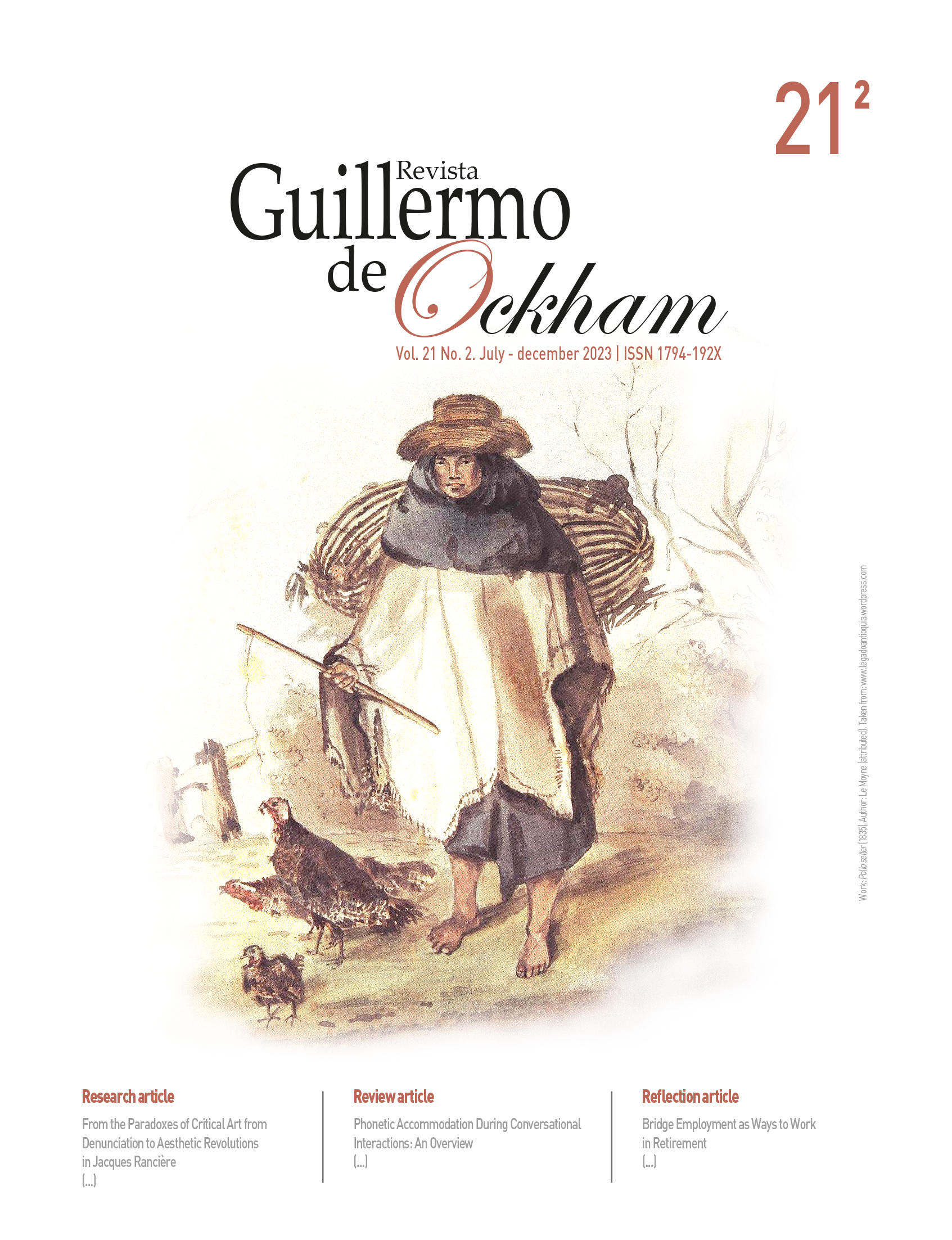The Revista Guillermo de Ockham provides an immediate and open access to its content, based on the principle of offering the public a free access to investigations to provide a global interchange of knowledge.
Unless otherwise established, the contents of this journal has a license with Creative Commons Attribution-NonCommercial-NoDerivatives 4.0 International (CC BY-NC-ND 4.0) http://creativecommons.org/licenses/by-nc-nd/4.0/
- Attribution: You must give appropriate credit, provide a link to the license, and indicate if changes were made. You may do so in any reasonable manner, but not in any way that suggests the licensor endorses you or your use.
- NonCommercial: You may not use the material for commercial purposes.
- NoDerivatives: If you remix, transform, or build upon the material, you may not distribute the modified material.
- No additional restrictions: You may not apply legal terms or technological measures that legally restrict others from doing anything the license permits.
Abstract
Religious art occupies a relevant place in the history of the Church and in a particular way in the faith experiences of believers where particular understandings of faith have been configured from theological teaching. This text aims to identify the unity and correlation between art and theology, and how these two aspects can enhance the experiences of faith and evangelization as paths of encounter that enable developments of special historical and ecclesial impact on the individual and community life of the believer. To this end, an exercise of historical reconstruction is made around the importance of art for the consolidation of theological knowledge and faith experiences, followed by a theological reading of beauty and its impact on the experience of faith and closes with a reference to the processes of evangelization through religious art. In this way, prospective routes of action are recognized that give space to the link between art, faith experience and evangelization.
Keywords:
References
Avenatti, C. I. (2006). Lo bello une, lo bello viene de Dios. Humanidades: Revista de la Universidad de Montevideo, 6(1), 135-146. http://revistas.um.edu.uy/index.php/revistahumanidades/article/view/110
Baena, G. (2005). El método antropológico trascendental. Theologica Xaveriana, (155), 351-378. https://revistas.javeriana.edu.co/index.php/teoxaveriana/article/view/20088
Belting, H. (2009). Imagen y culto: una historia de la imagen anterior a la edad del arte. Akal.
Borobio, D. (2000). Eucaristía. Biblioteca de Autores Cristianos.
Chong, V. (2020). Teología y liberación en el arte de Eduardo Kingman. Theologica Xaveriana, 70, 1-19. https://doi.org/10.11144/javeriana.tx70.tlaek
Concilio Vaticano II. (1965). Constitución pastoral: Gaudium et spes. https://www.vatican.va/archive/hist_councils/ii_vatican_council/documents/vat-ii_const_19651207_gaudium-et-spes_sp.html
De Roux, R. (2002). Experiencia de fe y creatividad artística. Theologica Xaveriana, (143), 473-488. https://revistas.javeriana.edu.co/index.php/teoxaveriana/article/view/20911
Dicasterio para la Cultura y para la Educación. (2004). La Via Pulchritudinis, camino de evangelización y de diálogo. http://www.cultura.va/content/cultura/es/pub/documenti/ViaPulchritudinis.html
Evdokimov, P. (1991). El arte del ícono: teología de la belleza. Publicaciones Claretianas.
Favier, C. (1962). Arte y teología. Proyección: Teología y Mundo Actual, (33), 131-133. https://dialnet.unirioja.es/servlet/articulo?codigo=7339566
Francisco. (2013). Exhortación apostólica: Evangelii gaudium. https://www.vatican.va/content/francesco/es/apost_exhortations/documents/papa-francesco_esortazione-ap_20131124_evangelii-gaudium.html
González-Bernal, E. (2021). The art of interpreting God’s action in the theology of three medieval mystic women. Verbum et Ecclesia, 42(1), 1-5. https://dx.doi.org/10.4102/ve.v42i1.2177
Lezcano, J. D. (2019). La experiencia de fe cristiana: gracia de Dios en la acción humana [Tesis de grado, Pontificia Universidad Javeriana]. Pontificia Universidad Javeriana. http://hdl.handle.net/10554/45008
Martínez, D. J. (2018). Revelación y belleza en la estética teológica de Hans Urs von Balthasar [Tesis de maestría, Universidad Pontificia de Comillas]. Repositorio Comillas. http://hdl.handle.net/11531/30647
Moraga, J. M. (2006). El misterio del Dios de Jesucristo: breve ensayo trinitario. Veritas: Revista de Filosofía y Teología, 1(14), 159-182. http://www.redalyc.org/articulo.oa?id=291122934008
Noratto, J. A. (2008). La vuelta de Jesús a los discípulos: los rostros de la parusía en el cuarto evangelio. Theologica Xaveriana, 58(166), 439-466. https://revistas.javeriana.edu.co/index.php/teoxaveriana/article/view/9415
Ochoa, S. K., Rúa, D. A., Granados, V. A., y Pérez-Vargas, J. J. (2021). Aportes de la pedagogía experiencial a la labor catequética. Cuestiones Teológicas, 48(109), 130-146. https://doi.org/10.18566/cueteo.v48n109.a09
Pellitero, R. (2008). Catequesis y teología de la belleza. Teología y Catequesis, 107-108, 151-164. https://hdl.handle.net/10171/42091
Pena, M. A. (2009). Evangelizar con el arte. En Á. Galindo (Coord.), Patrimonio cultural de la Iglesia y evangelización (pp. 147-159).Universidad Pontificia de Salamanca.
Plazaola, J. (1998). Razón y sentido del arte cristiano. Universidad de Deusto.
Plazaola, J. (1999). Historia del arte cristiano. Biblioteca de Autores Cristianos.
Radoslav, I. (1999). La esencia del arte cristiano. Aisthesis: Revista Chilena de Investigaciones Estéticas, (32), 9-16. https://revistaaisthesis.uc.cl/index.php/RAIT/article/view/5390
Ruiz, S. (2018). La evangelización en América Latina. Medellín: Biblia, Teología y Pastoral para América Latina y El Caribe, 44(171), 121-147.Ruiz de Loizaga, M. (2017). Hacia un arte litúrgico, según la concepción de Marko Ivan Rupnik: reflexiones sobre el arte sacro. Scripta Theologica, 49(3), 619-643. https://doi.org/10.15581/006.49.3.619-643
Ruiz de Loizaga, M. (2021). Una verdadera comunicación a partir del arte: la recuperación de la belleza y del símbolo, según la concepción de Marko Ivan Rupnik. Pensamiento: Revista de Investigación e Información Filosófica, 76(292), 1369-1387. https://doi.org/10.14422/pen.v76.i292.y2020.001
Sánchez, R. (2019). La evangelización en América Latina. Universidad Católica de Trujillo Benedicto XVI.
Santa Biblia: Reina-Valera actualizada (RVA). (2015). Bible Gateway. https://www.biblegateway.com/passage/?search=Colosenses%201&version=RVA-2015
Sobrino, J. (1984). Resurección de la verdadera Iglesia: los pobres, lugar teológico de la eclesiología. Sal Terrae.
Špidlík, T., y Rupnik, M. I. (2013). Teología de la evangelización desde la belleza. Biblioteca de Autores Cristianos.
Tamayo, J. J. (2011). Otra teología es posible: pluralismo religioso, interculturalidad y feminismo. Herder.
Vanrell, N. (2016). Imagen y misterio en la obra de arte acerca de la experiencia estética del amor encarnado a partir de La esencia de la verdad de Hans Urs von Balthasar y El Cristo de Velázquez de Miguel de Unamuno [Sesión de conferencia]. VI Congreso Internacional de Literatura, Estética y Teología, Buenos Aires, Argentina. https://repositorio.uca.edu.ar/handle/123456789/4356
Vizcaya, M. M. (2010). Concepción pedagógica creativa fundamentada en la teoría crítica educativa de Pablo Freire. Revista Educare, 14(1), 93-117. https://revistas.investigacion-upelipb.com/index.php/educare/article/view/249

 Perfil Google Scholar
Perfil Google Scholar







